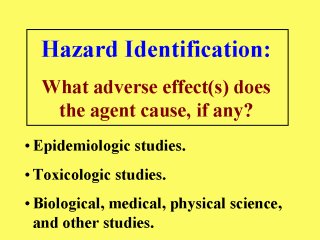|
|
|
|
front |1 |2 |3 |4 |5 |6 |7 |8 |9 |10 |11 |12 |13 |14 |15 |16 |17 |18 |19 |20 |21 |22 |23 |24 |review |
 |
Hazard identification is the part of the RA process that attempts to determine whether certain adverse health effects would occur if a person or a population were exposed to the (suspected) agent in question. As pointed out by the National Research Council (1983), the most convincing evidence or support for a causal relationship is a well-conducted epidemiologic study in which a positive association between exposure and disease has been observed. Well-conducted epidemiologic studies are hard to come by. The use of animal data from well-controlled experiments is thus a key part of the hazard identification component. At the least, the dose given to the test animals is much more quantifiable, compared to human exposure. The major problem with interpreting animal toxicological results is, however, that the test agent could have a different effect in animals than in humans. After all, the animal and human bodies are physiologically quite different. Animal bioassays are also very expensive to conduct and time-consuming. Other types of studies used in hazard identification include in vitro or short-term tests ranging from bacterial mutation assays performed entirely in vitro to more elaborate short-term bioassays such as skin-painting studies. A test substance’s physicochemical properties can also play an important role in providing information for hazard identification. |